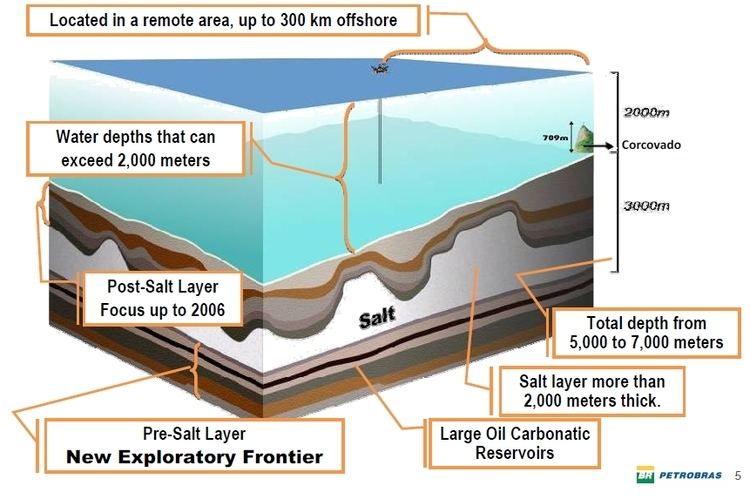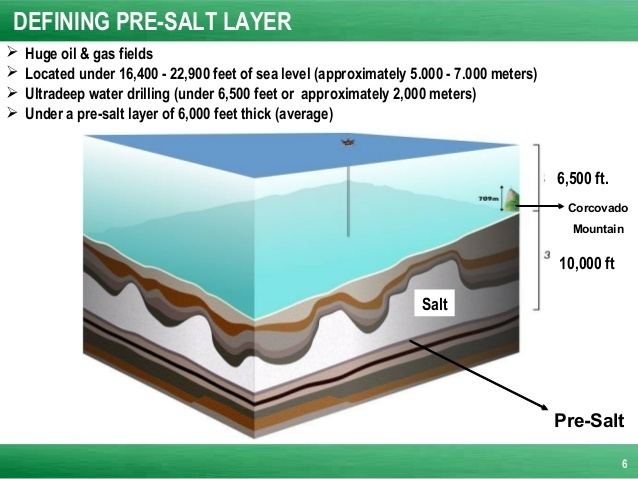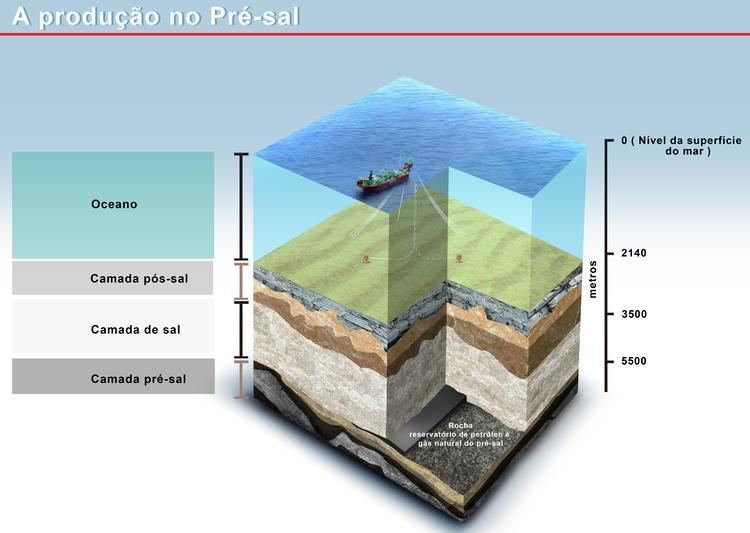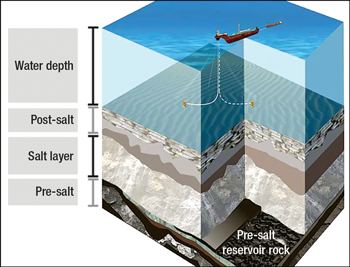 | ||
The Pre-salt layer is a geological formation on the continental shelves. It is the geological layers that were laid down before a salt layer accumulated above them during the Gondwana breakup. Some of the petroleum that was formed in the pre-salt layer has not leaked upward (see salt dome) to the post-salt layers above. This is especially common off the coast of Africa and Brazil. The amount of oil is not well known but is thought to be a significant fraction of world oil reserves. According to Petrobras, the oil and natural gas lie below an approximately 2000 m deep layer of salt, itself below an approximately 2000 m deep layer of rock under 2000-3000 m of the Atlantic. Drilling through the rock and salt to extract the pre-salt oil and gas is very expensive.

Pre-salt layer in Brazil and Angola

The current findings from Petrobras and other companies in the province of the Pre-salt, located in the Brazilian continental shelf, can mean reserves of over 50 billion barrels of oil, a volume four times greater than the current national reserves, roughly 14 billion barrels.

In this province, there may be large oil and natural gas reserves located under salt layers that extend for 800 kilometers along the Brazilian coast – from the state of Santa Catarina coast to the coast of Espirito Santo – up to 200 km wide.

Some estimates give the total area of the Pre-salt as 122,000 km2. Of this total, concessions have already been granted for 41,000 km2 and 71,000 km2 have not yet been tendered.

Pre-salt oil is of good quality, although it is found in reserves that are in deep-sea areas and under thick layers of salt, requiring large-scale investment to extract it.
Since 2006, Petrobras has sunk 11 oil wells in the Santos Basin. All these oil wells have been successful. At the prospects of Tupi and Iara alone, which are located in the BM-S-11 block, Petrobras already estimates that there are 8 to 12 billion barrels of recoverable oil. This block alone can almost double the current Brazilian oil reserves.
The first presalt discoveries in Angola were the Denden 1 well in block 9 in 1983, operated by Cities Services at the time, and the Baleia 1A well on block 20 in 1996, operated by Mobil (now ExxonMobil). Both blocks are now operated by the U.S.—based Cobalt International Energy. The Danish company Maersk Oil made the first recent presalt discovery in the Kwanza basin in late 2011 with the Azul well on block 23. Maersk continues to study the results of the well and plans to appraise it.
Cobalt has had the most success with presalt exploration in Angola, making multiple presalt well discoveries in blocks 20 and 21 (Cameia, Mavinga, Lontra, Bicuar, and Orca). Cobalt’s finds have encountered presalt hydrocarbons in the form of liquid and gas. Cobalt is the only company to have made a presalt discovery (Cameia field) in Angola that is commercially viable. The company plans to move toward sanctioning the Cameia field by the end of 2015. However, if oil prices remain low, a decision to develop will most likely be postponed.
In January 2011, Angola announced that it awarded 11 presalt offshore blocks in the Kwanza basin, following a closed licensing round in which a few selected IOCs were invited. IOCs that were awarded blocks include Petrobras, Maersk Oil, Cobalt, BP, Repsol, Total, Eni, ConocoPhillips, and Statoil. Some of those companies have slowed their investments in Angola’s presalt, and some wells have been closed and abandoned. The combination of disappointing results and geological complexity, compounded by the low-oil-price environment, has resulted in reduced investment in Angola’s presalt areas. Nonetheless, Angola is in the early stages of auctioning off 10 onshore blocks believed to hold presalt prospects in the Kwanza and Lower Congo basins.
